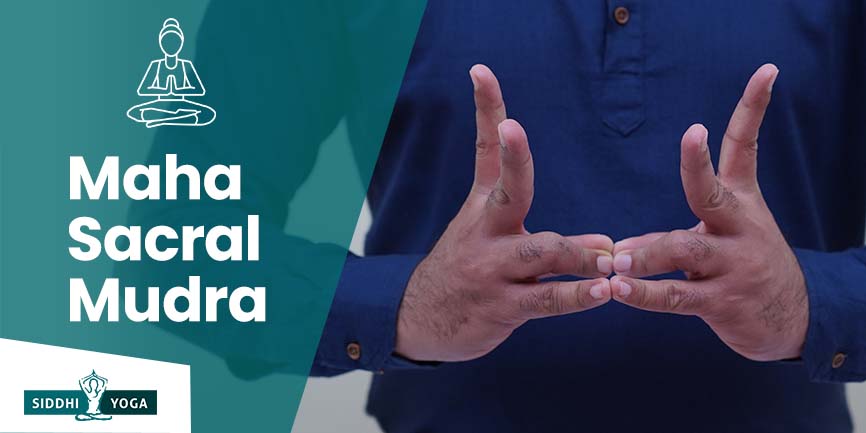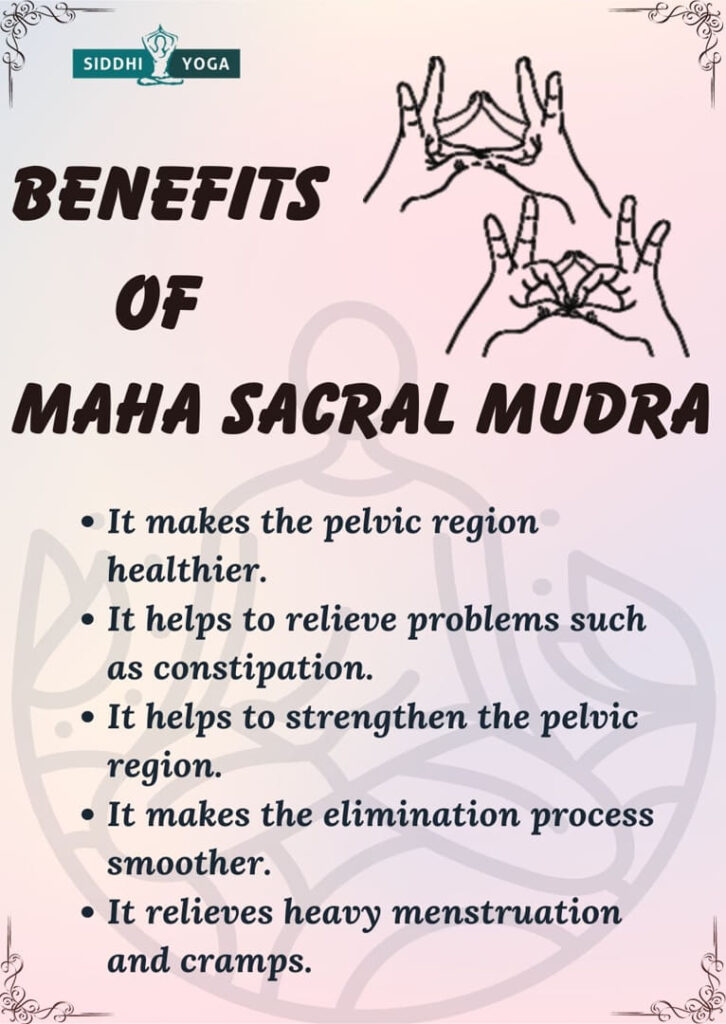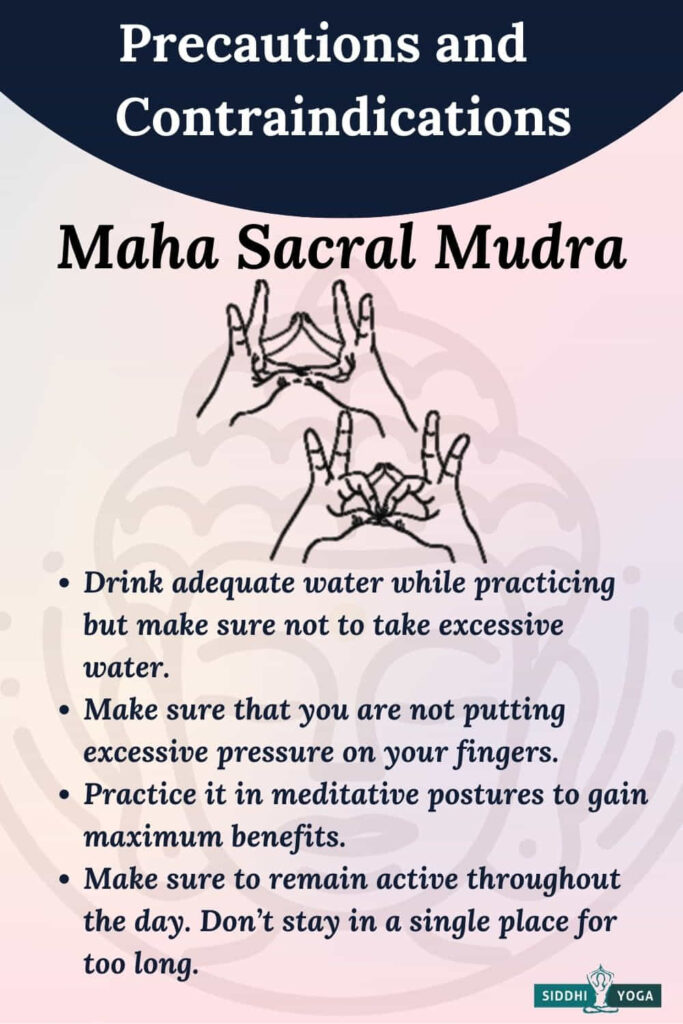
Maha Sacral Mudra is a Mudra that helps improve the body’s flow of energy. Read on to know more about the benefits, how to do it, and its meaning.
Definition – What is Maha Sacral Mudra and its Meaning, References, and Mythology?
Maha Sacral Mudra is also known as Lower Pelvic Mudra. It is one of the Hasta Mudras or hand gestures/seals. This Mudra is very useful for conditions related to our lower abdominal area. The pelvis is a very important region, and we often ignore this area when it comes to health. This Mudra helps to keep it healthy and helps to avoid health issues around it. The pelvis serves a great value. That is where our genitals are located along with the lower large intestine & rectum. A healthy pelvis is a necessity for both men and women. It should not be neglected.
In our pelvic region, some key muscles are located, known as pelvic floor muscles. These muscles are solely responsible for the defecation/excretion of waste. So, practicing this Mudra helps to strengthen those muscles, which gives you better control over your natural calls. It also helps to control the bladder.
Its healing powers help heal organs and systems in the pelvic region. It helps to relieve lower abdominal pain. If you experience intestinal spasms or bladder/prostate disorders, it will help you relieve those too. If you have such a condition, then you can try practicing it. It also helps to relieve menstrual aches and pains. So, it can be practiced during periods as well.
Older people are more likely to suffer from discomforts and problems caused in the pelvic region. Especially those who are more than 50 years old. One such problem is constipation; this Mudra helps to deal with them.
Alternate Name of Maha Sacral Mudra
Lower Pelvic Mudra.
How to Do Maha Sacral Mudra?
- This Mudra does require you to perform while you are seated in any meditative posture, as this Mudra requires more attention.
- It is believed that to maximize the benefits of this Mudra, you should practice it during meditation. You can start by sitting in Vajrasana (Thunderbolt Posture) or Padma Asana (Lotus Posture).
- Join your hands together in Namaste or Anjali Mudra at the heart level.
- Now, please keep all the fingers and thumb extended and spread them out.
- Then, slowly join the tip of your ring fingers together.
- Now slowly, and gently form a junction where the tips of your thumbs and your little fingers should be touching each other.
- Keep your neck and spine upright to avoid any aches and pains.
- Completely close your eyes.
- Practice deep breathing.
- You can perform this Mudra while practicing different forms of meditation and pranayama.
Maha Sacral Mudra Benefits

- It makes the pelvic region healthier.
- It helps to relieve problems such as constipation.
- It helps to strengthen the pelvic region.
- It makes the elimination process smoother.
- This Mudra helps you to stay calm and grounded. Which again improves your digestion.
- It prevents hyperacidity and diarrhea.
- It helps to control the condition of polyurination. So, we do not lose our salts and minerals excessively.
- It relieves heavy menstruation and cramps.
Maha Sacral Mudra Precautions and Contraindications

Similar to most of the Hasta Mudras, it has no side effects. However, you can keep a few things into consideration:
- Drink adequate water while practicing but make sure not to take excessive water. For a healthy adult, 2-3 Litres of water a day is enough.
- Make sure that you are not putting excessive pressure on your fingers.
- Practice it in meditative postures to gain maximum benefits.
- Make sure to remain active throughout the day. Do not stay in a single place for too long.
- Experts recommend not practicing this Mudra daily. You can practice this Mudra on alternate days. However, if you have some conditions, you can practice it more often.
When and how long to do Maha Sacral Mudra?
- You can practice it if you are struggling with constipation.
- This Mudra can be practiced if you have weak pelvic floor muscles.
- This Mudra can be practiced if your lower intestinal region is causing any issues.
- This Mudra can be practiced when you feel your body retains too much water.
- If you experience too many cramps and menstruation during periods.
Morning is the ideal time to do any yoga or Mudra. Our brain is at its best in the morning and during the daytime. So, you are more likely to be able to concentrate easily. Therefore, you should practice this Mudra from 4 am and 6 am to get the most effective outcomes.
If you are having difficulty with this during the morning, you can do this Mudra later in the evening too.
Based on research, the best way to practice an exercise for at least 20 minutes is to get the best benefits of that particular Mudra. Practicing this Mudra for a minimum of 10-15 mins alternatively is recommended. Whether you wish to complete it in one stretch or in two threes that last between 5 and 10 minutes, it’s up to you.
Breathing in Maha Sacral Mudra
To enhance your practice, you can practice breathing techniques with this Mudra.
- In diaphragmic breathing, when you inhale, let the belly come out and when you exhale, let the belly relax comfortably in.
Visualization in Maha Sacral Mudra
- Visualize that the positive energies are flowing through your spine.
- Your upright spine allows you to gain more energy without interruption.
- Visualize that these energies are healing your digestive system.
Affirmation in Maha Sacral Mudra
While practicing this, Keep a positive intention. Start with:
“I am a carrier of energy; I am in great shape and have achieved great health.”
Conclusion
The Maha Sacral Mudra is a Mudra, or hand gesture, that has been used in yoga and meditation for centuries. This Mudra is said to have many benefits, including reducing stress and anxiety, improving sleep quality, and boosting the immune system. If you’re interested in learning more about Mudras and how to use them effectively, check out our Mudras Certification Course. This course will teach you all 108 Mudras and their benefits so you can choose the right ones for your needs.